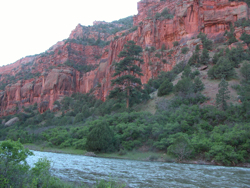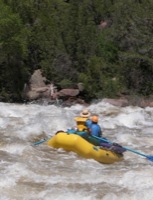Lower Dolores Working Group (CO)
 American Whitewater and various stakeholders have formed a Working Group in Colorado's Lower Dolores River Valley to update the US Bureau of Land Management's 1990 Dolores River Management Plan. The Working Group, which is organized by the Dolores River Dialogue, launched a year-long process in December 2008, to develop and evaluate alternatives to Wild and Scenic River designation on the Dolores below McPhee Dam, that can protect existing water rights and contractual obligations, while supporting the “Outstandingly Remarkable Values” that make the lower Dolores River suitable for inclusion into the Wild and Scenic Rivers system.
American Whitewater and various stakeholders have formed a Working Group in Colorado's Lower Dolores River Valley to update the US Bureau of Land Management's 1990 Dolores River Management Plan. The Working Group, which is organized by the Dolores River Dialogue, launched a year-long process in December 2008, to develop and evaluate alternatives to Wild and Scenic River designation on the Dolores below McPhee Dam, that can protect existing water rights and contractual obligations, while supporting the “Outstandingly Remarkable Values” that make the lower Dolores River suitable for inclusion into the Wild and Scenic Rivers system.
The one year process will be followed by an additional 6 month phase for the completion of a formal Environmental Assessment and Decision Notice for adoption of the update of the 1990 Corridor Management Plan. The process will be organized by the DRD in cooperation with the Dolores Public Lands Office of the San Juan Public Lands Center (SJPLC) which manages land and recreation for BLM and and National Forest Lands along the Dolores River from it's headwaters on Lizard Head Pass to McPhee Reservoir, and from McPhee Reservoir to eight miles below the confluence of the San Miguel and Dolores Rivers.
Meetings during all phases of the process will be open to the public, and opportunities will be provided for public comment.
Background
• The Wild and Scenic Rivers Act (1968). The act allows for the preservation and protection of “certain selected rivers” that possess “outstandingly remarkable scenic, recreational, geologic, fish and wildlife, historic, cultural, or other similar values. . .” It has been amended three times, most recently in 1975. At that time, Congress identified the Dolores River for study for possible designation as a Wild and Scenic River (“WSR”). Twenty-nine other rivers nationwide were also identified, 12 of them in Colorado. The portion of the Dolores recommended for study was from McPhee Dam to the Colorado border, a total of 194 river miles.
• Dolores River Wild and Scenic River Study Report (1976). This evaluated the river’s main stem from McPhee to Bedrock (105 miles). Segments were identified as either eligible or suitable for WSR designation under the following categories of WSR:
- McPhee to Bradfield Bridge — recreational
- Bradfield Bridge to Disappointment — scenic
- Disappointment to Little Gypsum — recreational
- Little Gypsum to 1 mile above Bedrock — wild
The study took place before the McPhee Dam was actually constructed, but its recommendations were based on the premise that McPhee would be built. The study’s authors believed the dam would “enhance most wild and scenic values” of the Dolores River.
• The BLM’s San Juan/San Miguel Resource Management Plan (1985). The plan identified a multiple-use emphasis for the Dolores River corridor with uses to include recreation, aquatic and riparian management, uranium-leasing, and Wilderness Study Areas. The plan designated 28,539 acres as the Dolores River Wilderness Study Area. It also specified that the Dolores River should be managed as a special Recreation Management Area and should have a Recreation Area Management Plan. Such a plan was developed and became the Dolores River Corridor Management Plan.
• The Dolores River Corridor Management Plan (1990). Its stated goals were to protect and enhance the natural and cultural resources of the corridor while allowing compatible uses. This is the plan the Working Group is to help update.
• The San Juan Public Lands Draft Revised Resource Management Plan (RMP) (2007). In the draft RMP, officials found the Dolores River from McPhee to Bedrock to be eligible for WSR listing. The draft plan also says a total of 109 miles of the Lower Dolores and some tributaries from McPhee to Bedrock is preliminarily suitable.
The plan also states, “Should the DRD make substantial progress in identifying and securing needed protections of the ORVs the recommendations of the group could be used to supplement or replace this finding of suitability.” WSR designation may or may not be the right tool for the Lower Dolores. The door is open for the group to do whatever it finds appropriate. The revised RMP should be finalized in 2010. It has been postponed because of the need to write a supplement regarding oil and gas development.

AW Grows it's Dolores River Campaign (CO)
01/03/2010 - by Nathan Fey
American Whitewater is pleased to announce that our Colorado Stewardship Program has been granted additional foundation support for it's work in the Dolores River basin. Funding for our Dolores River Project will enable AW to grow our advocacy role in the Dolores River basin, and engage our membership and affiliate networks to put to use the tools, resources, and partnerships available through our Stewardship Program.
The contacts below include staff and volunteers working on this project. Make sure you are logged in if you wish to join the group.
| Title | Name | City | |
|---|---|---|---|
| Nathan Fey | Longmont CO | Details... |
Associated News
Associated Gauges
| Gage | Reading | Last Updated |
| DOLORES RIVER NEAR SLICK ROCK, CO (AW#4191) | 68 cfs | 00h53m |
| DOLORES RIVER NEAR SLICK ROCK, CO (AW#4191) | 4.22 ft | 00h53m |
Associated Rivers
Associated Projects
Lower Dolores Working Group (CO)
AW is working with a broad group of stakeholders to draft a new federal legislation that protects water and the iconic landscapes of the lower Dolores River.
